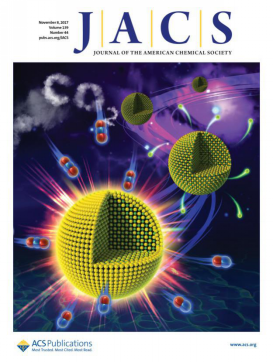Associate Professor Zhijiang Wang from the School of Chemistry and Chemical Engineering and Prof. William A. Goddard, a theoretical computational chemist from the California Institute of Technology, have made important progress in the field of electrocatalytic reduction of CO2. The research paper entitled “Ultrahigh Mass Activity for Carbon Dioxide Reduction Enabled by Gold−Iron Core−Shell Nanoparticles” was published in Journal of the American Chemical Society (2017, 139, 15608-15611, Impact Factor 13.858). Considering the important guiding role of this research for the design of high performance catalysts and the potential for the promotion of CO2 conversion industry, the paper was chosen to be the cover paper. The editor commented the paper through Spotlight.
The reduction of CO2 to carbon-based energy materials such as carbon monoxide and methane can decrease the atmospheric CO2 concentration and store renewable energy. Electrocatalytic reduction of CO2 is thought to be one of the most promising conversion technologies for CO2 utilization considering green power sources from solar or wind. Au based catalysts can reduce CO2 to CO with high selectivity. However, the high cost of Au remains the primary limiting factor preventing its widespread application in CO2 reduction. Alloying is an attractive way toimprove the catalytic performance and to reduce the amount of precious metals in the same time. Wang Zhijiang and co-authors used in silico quantum mechanics rapid screening to identify Au−Fe alloy as a candidate improving CO2 reduction from 20 metals and then synthesized and tested it experimentally. The synthesized Au−Fe alloy catalyst evolves quickly into a stable Au−Fe core−shell nanoparticle after leaching out surface Fe. This Au−Fe core−shell nanoparticle exhibits exclusive CO selectivity. At -0.40V (RHE), the nanoparticle can reduce CO2 exclusively to CO, with hydrogen evolution reaction almost entirely suppressed. The current density and Faradaic efficiency for CO2 conversion into CO remain almost constantly in the 90 hours duration test, indicating its superior stability toward CO2 reduction. Theoretical calculations suggest that this excellent performance toward CO2 reduction reaction arises from subsurface Fe combined with surface defects due to surface Fe leaching. This research provides an entirely new means to guide the fabrication of new catalysts and promotes the industrialization of CO2 reduction.
